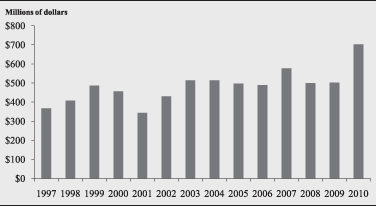Budgets: Chapter 4. Currency Budget
Each year, under authority delegated by the Board, the director of the Division of Reserve Bank Operations and Payment Systems orders new currency from the U.S. Department of the Treasury's Bureau of Engraving and Printing (BEP). Upon reviewing the order, the BEP establishes billing rates for new currency, which the Board staff uses to prepare the annual budget for new currency. Each month, the Board assesses the costs of new currency to each Federal Reserve Bank through an accounting procedure similar to that used in assessing the costs of the Board's operating expenses to the Banks. Total new currency expenses for 2009 were under budget by $129.3 million, or 20.5 percent, primarily because of delays associated with the new-design $100 note. In addition, the BEP requested that the Board move nearly 630 million notes from the fiscal year 2009 print order into the fiscal year 2010 print order.
The approved 2010 new currency budget of $702.9 million is 40.0 percent higher than 2009 costs (chart 4.1). Printing costs for Federal Reserve notes represent 96 percent of the new currency budget, and expenses for currency transportation, counterfeit-deterrence research, and the BEP's Finance Directorate operations account for the remaining 4 percent (table 4.1).
Federal Reserve Costs for New Currency, 1997-2010

NOTE: For 2010, budgeted.
d
| Item | 2009 (actual) | 2010 (budgeted) | Percent change |
|---|---|---|---|
| Printing of new Federal Reserve Notes1 | 479,255 | 677,613 | 41.4 |
| Currency transportation | 15,368 | 17,446 | 13.5 |
| Counterfeit-deterrence research | 3,913 | 4,208 | 7.5 |
| Reimbursement to the BEP's Finance Directorate | 3,609 | 3,650 | 1.1 |
| Total cost of currency | 502,145 | 702,918 | 40.0 |
1. Includes expenses for other currency-related initiatives. Return to table
Printing of Federal Reserve Notes
The calendar-year 2010 currency order will cost $676.9 million to print, a 41.2 percent increase from the cost for the 2009 order. This 41.2 percent increase is attributable to the larger number of more-expensive notes ordered, as well as the BEP producing fewer notes in 2009 than budgeted. The volume-weighted average billing rate per thousand notes increased 2.9 percent, from $86.36 in 2009 to $88.87 in 2010 (table 4.2); it increased largely because of the estimated cost for the Series 2004 $100 note, which accounts for approximately 36.1 percent of the 2010 order, and changes in both print-order volume and denomination mix. In addition, the 2010 new currency budget is also higher than 2009 costs because it contains a larger share of more-expensive Series 2004 notes than did the 2009 budget. Series 2004 notes account for 79.3 percent of the 2010 calendar-year budget, compared with 23.3 percent of the 2009 calendar-year budget. Specifically, the 2010 calendar-year budget includes nearly 2.8 billion Series 2004 $100 notes at the billing rate of $117.98 per thousand notes, amounting to $324.6 million, or 48.0 percent, of the total printing costs for the new currency budget.
| Type of currency | Number of notes (millions) | Percentage of total notes | Cost per thousand notes (dollars) | Total cost (thousands of dollars) |
|---|---|---|---|---|
| Unthreaded ($1, $2) | 1,469.8 | 19.3 | 48.07 | 70,651 |
| Series 1996 ($100) | 108.8 | 1.4 | 85.35 | 9,286 |
| Series 2004 | ||||
| $5 | 805.3 | 10.6 | 77.57 | 62,466 |
| $10 | 214.6 | 2.8 | 78.85 | 16,924 |
| $20, $50 | 2,267.0 | 29.8 | 85.11 | 192,948 |
| $100e | 2,751.2 | 36.1 | 117.98 | 324,588 |
| Volume-weighted average cost | … | … | 88.87 | … |
| Total | 7,616.7 | 100.0 | … | 676,863 |
e. Estimate. Return to table
… Not Applicable Return to table
Currency Transportation
The 2010 currency transportation budget is $17.4 million, which includes the costs of shipping new currency from the BEP to Reserve Banks ($8.5 million), of shipping fit and unprocessed currency between Reserve Banks ($8.9 million), and of returning currency pallets to the BEP ($45,000).
The 2010 budget for currency transportation increased 11.2 percent from 2009 costs. The overall increase reflects only a slight change in intra-System shipment costs, but a 17.9 percent increase in new currency shipment costs. This increase in the new currency shipment budget reflects projected costs to ship Series 2004 $100 notes from the BEP to every Reserve Bank in order to build sufficient inventories before issuance.
Counterfeit-Deterrence Research
The 2010 budget for counterfeit-deterrence research is $4.2 million, which includes the costs associated with the Central Bank Counterfeit Deterrence Group (CBCDG) and the Reprographic Research Center (RRC). The CBCDG, which includes 31 central banks, operates under the auspices of the G-10 central bank governors to combat digital counterfeiting. The Board's $4.2 million share of the 2010 CBCDG budget, which accounts for 99 percent of the Federal Reserve's counterfeit-deterrence budget, is 7.5 percent higher than the Board's share of the 2009 CBCDG costs.1
Bureau of Engraving and Printing Finance Directorate
The 2010 budget includes $3.6 million to reimburse the BEP for expenses incurred by its Destruction Standards and Compliance Division (DSCD) and Mutilated Currency Division (MCD). The DSCD develops Reserve Bank standards for cancellation and destruction of unfit currency and for note accountability; it also reviews Reserve Banks' cash operations for compliance with its standards. As a public service, the MCD processes claims for the redemption of damaged or mutilated paper currency.
Footnotes
- The estimated RRC payment of $36,000 represents the remaining 1 percent of the counterfeit-deterrence research budget. The RRC is a state-of-the-art facility, hosted by the National Bank of Denmark, that is used for adversarial testing of banknote designs and counterfeit deterrent features for its 13 member countries. Return to text


 Previous
Previous